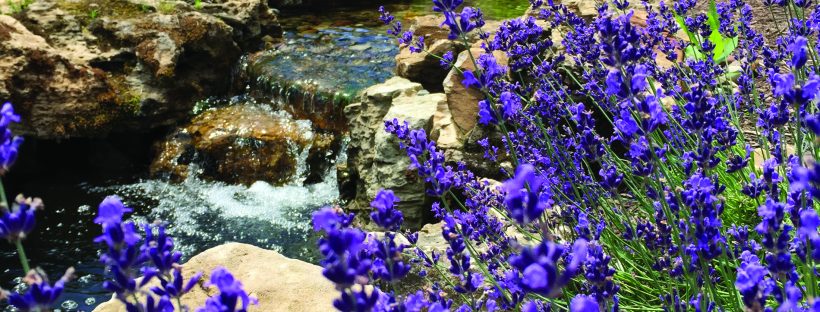
Biofiltration is a truly wonderful process. Water entering the bottom of the filter passes through layers of filter media. As the water slows sediments drop out, settling in the bottom of the filter. The filter media traps small debris and particles suspended in the water. Bacteria thrive on the filaments of media, metabolizing ammonia and nitrites excreted by aquatic animals and fish, turning toxic wastes into harmless nitrates which are in turn taken up by the plants in the pond. As it flows clean and clear out of the top of the filter, the water is aerated as it cascades back down into the pond, the final step of the process. Excellent water quality, clarity and oxygenation, all from one simple device that saves time and effort and typically only needs cleaning once or twice a year.
But maintenance, infrequent though it might be, is messy. The 25 fist-sized rocks that cover the tray need to be removed, the pads pulled out, the top pad kept in pondwater to preserve the bacterial colonies. The sludge coating the bottom of the filter and embedded in the filter pads is sticky and smelly, and tends to splatter all over when it’s hosed out of the pads. Considering all the work the FilterFalls has done all season, the hour-long odiferous ordeal is worth it.
But wouldn’t it be nice to eliminate most of the work, and just about all of the mess? With a little foresight and a couple of optional products you can make your FilterFalls practically maintenance free.
It all starts with the plumbing. To allow the FilterFalls to be easily backwashed without touching the filter at all, install a tee in the plumbing feeding the FilterFalls. The best spot is as close as possible to the filter, just before the bulkhead fitting into the falls box, so this is easiest to do before the filter is installed. However, as long as you can find the pipe from the skimmer to the bottom of the FilterFalls, it is relatively simple to cut in a tee. One leg of the tee will let the water continue flow into the FilterFalls as it would with a straight pipe. On the other leg of the tee install a valve then run a piece of tubing out to daylight. Put a scrap piece of vertical pipe large enough to provide access to the valve from above before backfilling around the valved tee.
The second enhancement not only makes the filter easier to clean, it also improves the filtration process. Consider replacing the dual polypropylene mats that come with every FilterFalls with a filter upgrade, the Matala Mat Kit. Matala is a rigid mat material that rinses more easily than the standard poly mats. The Kit comes with a Fine, Medium and Coarse Mat; each FilterFalls can accommodate up to two Kits. The Coarse mats go on the bottom, Fine on top and they greatly increase the filtering capacity. Better yet, Matala rinses clean easily, unlike poly pads that need to be washed under pressure with a jet of water.
The new cleaning procedure begins with turning off the pump. The check valve in the skimmer will keep the biofilter full of water. Open the valve to allow the water in the FilterFalls to backwash through the Matala Mats pads and out the inlet pipe, washing the trapped gunk (the technical term for settled organic solids) out of the filter.
Most of the muck in the pads just backwashes out when the valve is opened, without opening the filter or even removing the rocks in the tray. Rinse by closing the valve and turning the pump back on to refill the filter, stopping the pump as the filter begins to overflow and opening the valve again. Repeat until the backwash water comes out clear. If desired, you can ‘power rinse’ the filter by simply pouring a pail of water into the top of the FilterFalls. All done, no mess, no fuss.
For more information on FilterFalls click here.
About the Author:

DEMI FORTUNA
Demi has been in water garden construction since 1986. As Atlantic’s Director of Product Information, if he’s not building water features, he’s writing or talking about them. If you have a design or construction question, he’s the one to ask.


